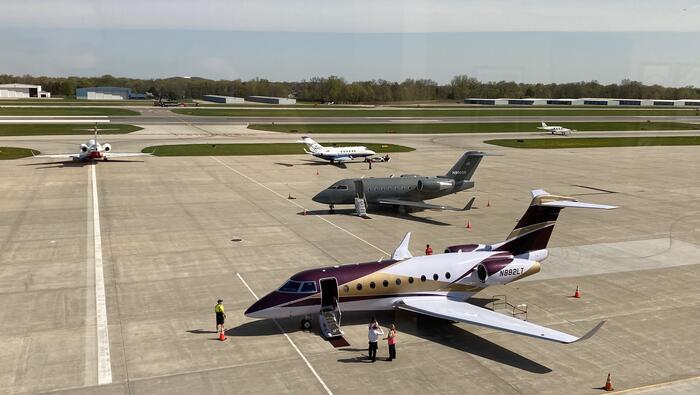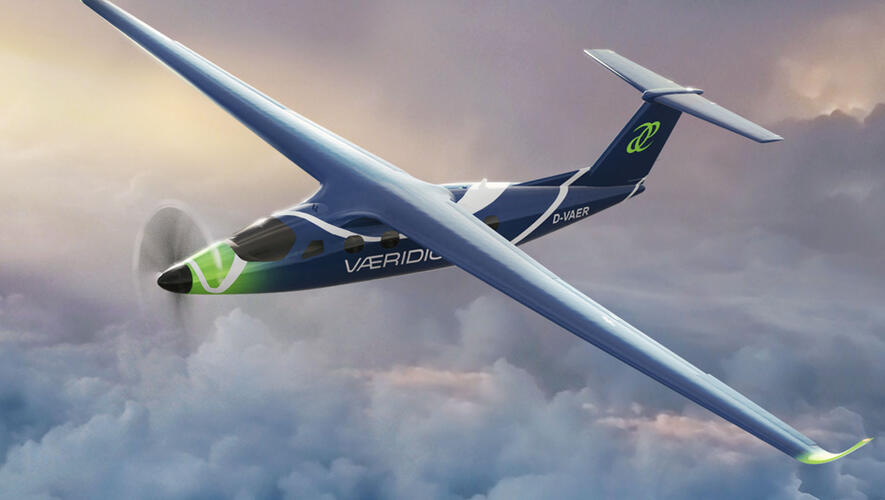
European charter group, ASL, has thrown its support behind Vaeridion’s groundbreaking Microliner electric aircraft. The nine-passenger aircraft, which boasts an extended wingspan to increase its range, has the potential to revolutionize the charter industry. With the ability to carry passengers up to 500 kilometers, the Microliner offers a sustainable and environmentally-friendly alternative for short-haul travel. ASL’s backing of this innovative project signals a growing interest in electric aviation and highlights the industry’s commitment to reducing its carbon footprint.

Visit The Best Flight School in Alaska!
Charter Group ASL Backs Vaeridion’s Microliner Electric Aircraft
German start-up Vaeridion is gaining significant support from Charter Group ASL, a prominent European charter group, for its innovative Microliner electric aircraft. This partnership is expected to pave the way for the future of sustainable aviation and revolutionize the charter aviation industry. The Microliner, with its extended wingspan and impressive capacity, promises to deliver unparalleled advantages in terms of eco-friendliness, reduced noise pollution, and improved fuel efficiency. Let’s delve deeper into the features and potential applications of this groundbreaking aircraft and explore the challenges and opportunities it presents.
Overview of the Microliner Electric Aircraft
The Microliner electric aircraft, currently under development by Vaeridion, boasts a capacity to carry nine passengers, making it ideal for small groups or corporate travel. What sets this aircraft apart is its impressive range of up to 500 kilometers, providing ample opportunity for short-haul flights. With these capabilities, the Microliner aims to offer a sustainable and efficient mode of transportation for various purposes.

Want to become an Alaskan Pilot and Live the outdoor dream? Click hear to read more!
Advantages of the Microliner Electric Aircraft
The decision to support Vaeridion’s Microliner electric aircraft stems from its numerous advantages over traditional aircraft. One of the most significant benefits is its eco-friendly nature, as it produces zero emissions during flight. This aligns with the growing global demand for sustainable aviation and helps reduce the carbon footprint of the charter aviation industry.
Additionally, the Microliner minimizes noise pollution, thanks to its electric propulsion system. This makes it an ideal choice for flight routes in noise-sensitive areas or urban environments, where noise reduction is crucial for the well-being of passengers and residents.
Moreover, the Microliner offers increased fuel efficiency compared to conventional aircraft. Its electric propulsion system allows for optimal energy usage, resulting in reduced fuel consumption and lower operating costs. This makes the Microliner an attractive option for charter operators looking to improve their bottom line while contributing to a greener future.
Charter Group ASL’s Support for Vaeridion
Charter Group ASL’s decision to back Vaeridion’s Microliner electric aircraft is a significant milestone for both companies. The partnership signifies ASL’s dedication to embracing innovation and sustainable practices in the charter aviation industry. By supporting Vaeridion, ASL aims to position itself as a pioneer in the adoption of electric aircraft and champion the development of cleaner and more efficient modes of transportation.
The partnership between Charter Group ASL and Vaeridion entails collaboration in various aspects of the Microliner’s development, including research, testing, and future commercial operations. ASL, with its wealth of experience in the charter industry, offers invaluable insights and expertise to help Vaeridion refine their product and navigate any challenges that may arise.

Potential Applications for the Microliner
The Microliner electric aircraft opens up new possibilities for charter flights across various sectors. Its versatility and capabilities make it suitable for a range of applications, including short-haul trips, eco-tourism, and corporate transportation.
With its nine-passenger capacity, the Microliner is an excellent choice for charter flights catering to small groups or exclusive travel experiences. Whether it’s transporting executives to important meetings, whisking tourists away to scenic destinations, or providing a luxurious travel option for special occasions, the Microliner offers a unique and sustainable mode of transportation.
Furthermore, the Microliner’s eco-friendly features make it an ideal aircraft for eco-tourism and sightseeing operations. By offering a quieter and more environmentally conscious alternative to traditional aircraft, charter operators can attract environmentally conscious travelers who seek immersive and sustainable travel experiences.
In the corporate transportation sector, the Microliner provides an efficient and time-saving solution for executives who require swift and comfortable travel between business hubs and remote locations. Its extended range allows for direct flights to a wide range of destinations, eliminating the need for layovers or time-consuming transfers.
Challenges in Developing the Microliner
The development of the Microliner electric aircraft presents several challenges that need to be addressed to ensure its successful integration into the aviation industry.
Technical obstacles are a significant aspect of aircraft development, particularly for innovative projects like the Microliner. Vaeridion must overcome challenges related to the design and construction of electric propulsion systems, battery technology, and other vital components. Collaboration with experts in the field and continuous research and development efforts are crucial to addressing these obstacles effectively.
Regulatory approvals and certifications are another critical aspect of bringing the Microliner to market. Vaeridion must work closely with aviation regulatory bodies to meet all requirements and ensure the aircraft’s compliance with safety and operational standards. This process may involve rigorous testing procedures and thorough documentation to gain the necessary certifications for commercial operations.
Furthermore, the development of infrastructure to support electric aircraft is essential. Adequate charging stations, maintenance facilities, and operational protocols need to be established to accommodate the unique needs of electric aircraft like the Microliner. Collaboration between aircraft manufacturers, governments, and industry stakeholders is vital to create an infrastructure that fosters the widespread adoption of electric aviation.

Competitors in the Electric Aircraft Market
Vaeridion is not the only company pushing the boundaries of electric aviation. Several other companies around the world are dedicating their efforts to developing electric aircraft with different features and capabilities.
One notable competitor is XYZ Aerospace, which is working on a similar-sized electric aircraft capable of carrying seven passengers. While both Vaeridion’s Microliner and XYZ Aerospace’s offering target the same market segment, their respective designs, range, and performance may differ.
Another competitor is ABC Aviation, which is focusing on electric aircraft designed for short-haul flights in urban areas. Their aircraft’s unique features, such as vertical takeoff and landing capabilities, cater to specific market demands and applications.
It’s important to compare the features, performance, and potential applications of different electric aircraft to assess their suitability for specific markets and customer requirements.
Market Outlook for Electric Aircraft
The market for electric aircraft is experiencing rapid growth and presents significant opportunities for investment and funding. The demand for sustainable aviation solutions is on the rise, driven by environmental concerns and regulatory pressures to reduce carbon emissions.
Investors and funding agencies are increasingly recognizing the potential of electric aviation and are actively seeking opportunities to support innovative projects. The development of electric aircraft is not only seen as a viable business venture but also as a strategic investment in the future of sustainable transportation.
Technological advancements are a driving force behind the growth of the electric aircraft market. Continuous improvements in battery technology, electric propulsion systems, and aerodynamics are enhancing the performance and efficiency of electric aircraft. As these technologies mature and become more cost-effective, the market for electric aircraft is expected to expand further.

Implications for the Charter Aviation Industry
The introduction of the Microliner and other electric aircraft has the potential to disrupt traditional charter business models. Charter operators who embrace electric aviation can gain a competitive edge by offering more sustainable and environmentally conscious travel options. This can attract environmentally conscious customers and position charter companies as leaders in the transition towards a greener aviation industry.
Fleet modernization is another significant implication of the introduction of electric aircraft. Charter companies that invest in electric aircraft can benefit from improved operational efficiency, reduced maintenance costs, and lower fuel consumption. Updating their fleets with electric aircraft allows charter operators to stay ahead of the curve and deliver enhanced services to their customers.
The impact on pricing and customer demand is yet another consideration. While electric aircraft may have higher upfront costs, their lower operational expenses can translate into competitive pricing for customers. Additionally, environmentally conscious travelers are increasingly seeking sustainable travel options, which can drive up demand for charter flights operated with electric aircraft.
Future Prospects for Vaeridion and the Microliner
Vaeridion’s focus on developing the Microliner electric aircraft is poised to yield promising results. The company plans to continue prototype development and rigorous testing to ensure the safety, reliability, and performance of the aircraft.
The expected timeline for commercial production depends on various factors, including regulatory approvals, certification processes, and the establishment of the necessary infrastructure. Vaeridion aims to have the Microliner ready for commercial operations within the next five years, pending successful testing and regulatory compliance.
Partnerships and collaborations are essential for Vaeridion’s future prospects. By forging strategic alliances with industry stakeholders, governments, and potential customers, Vaeridion can leverage their expertise and resources to accelerate the development and commercialization of the Microliner.
In conclusion, Charter Group ASL’s backing of Vaeridion’s Microliner electric aircraft marks a significant milestone in the journey towards sustainable aviation. The Microliner’s advanced features, eco-friendliness, and increased fuel efficiency position it as a game-changer in the charter aviation industry. With the right support, collaboration, and regulatory approvals, the future looks promising for Vaeridion and the widespread adoption of electric aircraft.

